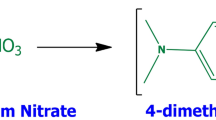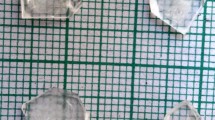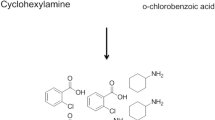Abstract
Good quality needle shaped (14 × 3 × 3 mm3) single crystals of ammonium mercury chloride thiocyanate (NH4[HgCl2(SCN)]; AMCTC) were grown using slow solvent evaporation method for the first time. The incorporation of thiocyanate ligand is confirmed by the strong and highly intense FT-IR band observed at 2112.0 cm−1, which corresponds to the stretching frequency vibration of CN. The signal at about 120 ppm of FT-NMR spectrum is a strong evidence, which in turn supports the binding of thiocyanate in the resulting compound of AMCTC. Further, the sample was also subjected to UV–Vis–NIR and TG–DTA and DSC studies to understand the range of optical transparency and thermal stability of the sample, respectively. The melting point of AMCTC is found to be 151.7 °C. The powder second harmonic generation efficiency of the sample is superior to potassium dihydrogen phosphate.
Similar content being viewed by others
Explore related subjects
Discover the latest articles, news and stories from top researchers in related subjects.Avoid common mistakes on your manuscript.
Introduction
In recent days, nonlinear optical crystals play an important role in the development of photonics technology. Photonics is the analog of electronics in which photons, instead of electrons, are used in the acquisition, storage, transmission, and processing of information. In photonics, a growing need continues for low cost, high nonlinearity, efficient and high quality crystals for a wide range of optical applications [1–3]. However, it is a matter of fact that most of the materials often limited by the spectral range as well as the factors such as the quality, cost, growth condition, and the ease of engineering of the crystals. In addition, a wide range of optical transparency is a prime factor in second-order nonlinear optical (SONLO) device applications [4]. It is interesting to note that the metal thiocyanate complex family crystalline compounds offer a variety of molecular structures by virtue of the changes brought out in selection of metals, ligands, coordination numbers and so on. These complexes are capable of efficient frequency conversion of infrared laser radiation into visible and ultra violet wavelengths and are developed on the basis of the molecular engineering method and the double-ligand model [5–7]. In metal thiocyanate complexes, the thiocyanate (SCN) plays a crucial role in combining the versatile ambidentate ligand with two donor atoms. It can coordinate through either the nitrogen or the sulfur atom, or both, giving rise to linkage isomers or polymers [8–12]. The resonance structures are: −S–C≡N(A) ↔ S=C=N−(B) ↔ +S≡C–N2−(C). The relative importance of the resonance structures follows the trend A > B ≫ C. The modes of metal coordination with thiocyanates are best understood in terms of the hard–soft acid–base (HSAB) concept. In accordance with the HSAB concept, the S atom of the SCN− ligand, being a soft base, preferentially coordinates to the soft acid, whereas the N atom, being a hard base, preferentially coordinates to the hard acid. It is also a known fact that the bidentate SCN ligand with a hard N atom and a softer S atom is capable of forming polymeric structures with transition metal atoms such as Cd, Hg, Zn, and Mn. In the present study, an attempt was primarily made to get a crystalline material with the non-centrosymmetric coordination and also expecting the larger transparency width by introducing the metal ions (Hg2+) and halogen ions (Cl−) [4]. In order to achieve the above, efforts have been made to grow the Ammonium mercury chloride thiocyanate (NH4[HgCl2(SCN)]) (abbreviated as AMCTC) single crystals using slow solvent evaporation technique. The crystal structure of NH4[HgCl2(SCN)] was already reported by Grossmann in 1903 and latter by Aissa Gacemi et al. in 2003 [13]. However, the structural aspects of AMCTC were alone mainly emphasized by both the Scientists and coworkers. In addition, no bulk size crystal of AMCTC was grown and reported so far and the systematic investigations on spectral, optical, thermal studies were also not reported elsewhere. Hence, in the present study, the preliminary investigations such as single crystal XRD, FT-IR were made to confirm the crystalline nature and the functional groups of AMCTC. Further, the FT-NMR and UV–Vis–NIR studies were also carried out on the sample for the first time. The second harmonic generation (SHG) efficiency and TGA–DTA/DSC thermal studies were also made on the grown crystal of AMCTC to understand the suitability of the material for SONLO applications.
Experimental
Materials
All the raw materials (NH4SCN and HgCl2) used in the growth process were as purchased and of analytical reagent grade (MERCK).
Crystal growth
Single crystals of AMCTC were grown using slow solvent evaporation. An equimolar mixture of ammonium thiocyanate and mercury chloride were dissolved in the solvent of ethanol as mentioned in the equation and stirred well.
The resulting solution was filtered and kept under slow evaporation at room temperature for spontaneous nucleation. Gacemi et al. [13] have grown only millimetric size needle crystals only. However, in the present study , good quality, transparent, and well-defined needle shaped single crystals (14 × 3 × 3 mm3) of AMCTC were obtained over a period of 2 weeks. The as grown single crystals of AMCTC are shown in Fig. 1.
Characterization
Single crystal X-ray diffraction (SXRD) analysis
Single crystal X-ray diffraction (SXRD) is an analytical technique in which X-rays are employed to determine the actual arrangement of atoms within a crystalline specimen. SXRD studies of AMCTC were carried out using Enraf–Nonius CAD-4F single crystal X-ray diffractometer with Mo Kα radiation. The structure was solved by direct method and refined by the full matrix least-squares technique using the SHELXL program. The SXRD studies clearly show that the grown crystals of AMCTC belong to monoclinic crystal system (space group P2 1) with the lattice parameters a = 9.273(1) Å, b = 4.168(2) Å, and c = 9.186(1) Å, Z = 2. The cell parameters obtained in the present study are in good agreement with the reported work [13].
FT-IR studies
Figure 2 shows the FT-IR spectrum of AMCTC single crystal recorded in the region 4,000–400 cm−1 using BRUKER IFS 66 V spectrometer. The functional groups of AMCTC were confirmed and compared with CMTC and NH4SCN as mentioned in Table 1. It is a known fact that the bonds between the atoms of higher masses will vibrate at lower frequencies than the bonds bearing the lighter atoms. The mass of sulfur (S) is greater than the mass of nitrogen (N). Hence, the CN stretching is the most predominant and higher than CS stretching. It is very interesting that the incorporation of thiocyanate ligand in the resulting compound is confirmed by the strong and highly intense band observed at 2112.0 cm−1, which corresponds to the stretching frequency vibration of CN. It is also evident that the CN stretching is shifted from 2,075 cm−1 (free thiocyanate ion) to 2,112 cm−1 (AMCTC), which suggests the strong binding of SCN with transition metal ion (Hg2+). The CS stretching and SCN bending vibrations are well identified at 713 and 464 cm−1, respectively. However, the structural aspect of the AMCTC reveals that the Hg metal atom is linked to one sulfur (S) atom of SCN in linear geometry and five chlorine atoms, which result in a distorted octahedral environment [13].
FT-NMR studies
The Fourier transform nuclear magnetic resonance study of AMCTC was recorded using Jeol GSX 400 NB FT-NMR Spectrometer in the range 0–200 ppm. Figure 3 shows the FT- NMR profile of AMCTC. The formation of thiocyanate and isothiocyanate complexes can be easily detected by the characteristic 13C signal for the –SCN and –NCS groups that are usually found at about 111 and 145 ppm, respectively. If the carbon atom present in the resulting compound is different, then the individual carbon atom can be observed in the spectrum. Since AMCTC contains carbon atom belonging to thiocyanate (SCN) ligand, the spectrum has displayed a signal at about 120 ppm. Further, the peak observed at 47.87 ppm may be assigned to the solvent DMSO. The above signal (120 ppm) is a strong evidence for the incorporation of thiocyanate (SCN) ligand with the Hg metal ion in the resulting compound of AMCTC.
UV–Vis–NIR studies
The optical absorption spectrum of AMCTC recorded using ethanol as a solvent in the region 200–1,600 cm−1 is shown in Fig. 4. It is a known fact that the wide optical transparency of a sample is one of the criterions required for frequency doubling applications. The UV cut-off wavelength of AMCTC lies at about 250 nm (Fig. 5), which is far better than the other metal thiocyanate complexes such as CdHg(SCN)4 (CMTC) (371 nm) [14], MnHg(SCN)4 (MMTC) (372 nm) [15], Hg(N2H4CS)4Mn(SCN)4 (TMTM) (350 nm) [16], and Hg(N2H4CS)4Zn(SCN)4 (TMTZ) (330 nm) [17]. It is interesting to note that the AMCTC possesses very less absorption over a wide range of wavelength starting from infrared to ultraviolet region, which might have been due to the coordination of halogen ion (Cl−) with Hg in the resulting compound.
Nonlinear optical studies
The SHG study was carried out on the AMCTC sample using Kurtz and Perry powder technique. Q-switched, mode locked Nd3+:YAG laser emitting 1.06 micro meter radiation was used as a source. The crystalline size of AMCTC was made comparable to the crystalline size of KDP. Input laser pulse of energy 2.26 mJ was fed into the sample of KDP and thereby output second harmonic signal of 82 mV was obtained. Then, the same procedure was repeated for the test sample of AMCTC. Consequently, the output second harmonic signal (320 mV) was measured. Hence, the SHG efficiency of AMCTC is found to be far better than KDP. However, it is inferior to the other organometallic analogs such as CdHg(SCN)4 (CMTC) [14] and MnHg(SCN)4 (MMTC) [15].
AC-conductivity studies
The AC-conductivity measurements were taken using a conventional four probe set up model DFP-02 and HEWLETT PACKARD 4284A Precision LCR meter in the frequency range 20 Hz to 5 mHz. The sample was subjected to a temperature variation from 303 to 363 K. The electrical conductance with reference to the log frequency is plotted (Fig. 6). In AMCTC, the resistance of the sample found to decrease with the increase in the temperature from 303 to 363 K. Hence, it is evident from the graph that the conductivity increases with the temperature. It is interesting that the sample AMCTC exhibits Arrhenius type conduction behavior in the above said temperature range. The activation energy of AMCTC is found to be 0.283 eV.
Thermal studies
In the present study, the TG–DTA and DSC studies of AMCTC were carried out in the temperature range 28–1,200 and 24–160 °C using NETZSCH STA 409 C thermal analyzer and NETZSCH DSC 204 instrument, respectively, under nitrogen atmosphere, at a heating rate of 10 K min−1. Initially, 21.850 and 18.770 mg samples were loaded into respective crucibles of TG–DTA and DSC instruments, which were controlled by a microprocessor driven temperature control unit. Figures 7 and 8 show the TG–DTA and DSC curves of AMCTC. The DSC trace of AMCTC shows that the sample melts at 151.7 °C with an on set temperature of about 145 °C, which is comparable to the first DTA endothermic peak observed at 144 °C. However, the thermal decomposition of AMCTC starts immediately after melting and proceeds in three different successive stages. The sharp DSC endothermic peak just at 151.7 °C is due to melting. Further, both TGA and DSC traces also indicate that there is no weight loss up to 145 °C, illustrating the absence of water of crystallization. Hence, the sample of AMCTC can be utilized up to 145 °C for device fabrications. The sharp exothermic peak observed at 178.7 °C shows a phase change from which AMCTC gets fragmented into various components such as ammonium chloride (NH4Cl), mercury sulfide (HgS), and dicyanogen ((CN)2). It is meaningful to mention that the thermal stability of AMCTC (151.7 °C) is comparable to CMTD (150 °C) [18] and superior to the other semi-organic coordination complex crystals such as CMTG (100 °C) [18], BTCoC (110 °C) [19], and ATZC (58 °C) [2].
Conclusions
An interesting category of AMCTC single crystals were grown using slow evaporation technique. The FT-IR and 13C NMR studies confirmed the incorporation various functional groups of AMCTC. The cell parameters of grown crystals were confirmed using single crystal XRD. The UV cut-off wavelength of AMCTC is found to be 250 nm, which is superior to the other organometallic crystals such as CMTC (371 nm), MMTC (372 nm). It is also inferred from the optical absorption spectrum that the incorporation of halogen ions (Cl−) with mercury in the resulting compound of AMCTC might have enhanced the optical transparency of the sample over a wide range of wavelength. The melting point of AMCTC is found to be 151.7 °C, which is comparable to CMTD (150 °C). However, it is superior to ATZC (58 °C), CMTG (100 °C). The SHG efficiency of AMCTC is found to be far better than KDP. The preliminary investigations show that AMCTC is one of the suitable frequency conversion materials which may be used to replace the conventional one in near future.
References
Guo S, Xu D, Mengkai Lv, Yuan D, Yang Z, Zhang G, Sun S, Wang XQ, Zhou M, Jiang M, Yang P, Yu W. A novel organometallic nonlinear optical complex crystal: cadmium mercury thiocyanate dimethyl-sulphoxide. Prog Cryst Growth Charact Mater. 2000;111:114.
Sun HQ, Yuan DR, Wang XQ, Cheng XF, Gong CR, Zhou M, Xu HY, Wei XC, Luan CN, Pan DY, Li ZF, Shi XZ. A novel metal-organic coordination complex crystal: tri-allylthiourea zinc chloride (ATZC). Cryst Res Technol. 2005;882:886.
Zhou M, Yu WT, Xu D, Guo SY, Lu MK, Yuan DR, Z Kristallogr NCS. 2000;215:425.
Mosset A, Bagieu-Beucher M, Lecchi A, Masse R, Zaccaro J. Crystal engineering strategy of thiocyanates for quadratic nonlinear optics. Hg3CdCl2(SCN)6 and Hg4CdBr4(SCN)6. Solid State Sci. 2002;827:834.
Szczygie IE, Jagoda Z, Kiak J, Korabik M. {[NiL][Co(NCS)4]}n, an organic–inorganic coordination polymer (L = 5,12-dimethyl-1,4,8,11-tetraazacyclotetradeca-4,11-diene) spectroscopic, magnetic and thermal characteristics. J Therm Anal Calorim. 2012;677–84.
Upadhya KM, Udayashankar NK. Synthesis, microhardness, FT-IR and thermal decomposition of semiorganic antimony thiourea bromide monohydrate single crystals. Int J Thermo Phys. 2012;135–42.
Gopinath S, Barathan S, Rajasekaran R. Growth and studies of thiourea urea magnesium chloride (TUMC) single crystals. J Therm Anal Calorim. 2012;841–845.
Vetha Potheher I, Rajarajan K, Jeyasekaran R, Vimalan M, Yogam F, Sagayaraj P. Growth, optical, thermal, and conductivity behavior of nonlinear optical single crystals of CdHg(SCN)4(CH3OC2H5O). J Therm Anal Calorim. 2012;1–7 (article in press).
Vetha Potheher I, Rajarajan K, Vimalan M, Tamilselvan S, Jeyasekaran R, Sagayaraj P. Investigation on the optical and electrical properties of MMTG crystal: a lewis base adduct. Physica B. 2011;3210–14.
Rajarajan K, Mani G, Vetha Potheher I, Joe Jesudurai GM, Vimalan Christy D, Madhavan J, Sagayaraj P. Growth, optical, dielectric, and ESR studies on tetrathiourea mercury(II) tetrathiocyanato manganate(II): an organometallic complex NLO crystal. J Phys Chem Solids. 2007;2370–75.
Rajarajan K, Joseph GP, Ravikumar SM, Vetha Potheher I, Joseph Arul Pragasam A, Ambujam K, Sagayaraj P. Growth and optical studies of a novel organometallic complex NLO crystal: tetrathiourea cadmium(II) tetrathiocyanato zinc(II). Mater Manuf Process. 2007;370–74.
Vetha Potheher I, Rajarajan K, Nagaraja S, Sagayaraj P. Growth and characterization of diaquatetrakis (thiocyanato) cobalt(II) mercury(II) N-methyl-2-pyrolidone (CMTWMP) single crystals. J Crystal Growth. 2008;124–30.
Gacemi A, Benbertal D, Bagieu-Beucher M, Lecchi A, Mosset A. Two mercury chloro thiocyanate complexes: NH4[HgCl2(SCN)] and NH4[HgCl(SCN)2]. Z Anorg Allg Chem. 2003;2516:2520.
Wang XQ, Xu D, Lü MK, Yuan DR, Zhang GH, Meng FQ, Guo SY, Zhou M. Investigation of bimetallic thiocyanates belonging to ABTC structure type: ZnCd(SCN)4 and AHg(SCN)4 (A = Zn, Cd, Mn) as nonlinear optical crystal materials. Cryst Res Technol. 2001;73:84.
Wang XQ, Xu D, Lu MK, Yuan DR, Xu SX. Crystal growth and characterization of the organometallic nonlinear optical crystal: manganese mercury thiocyanate (MMTC). Mater Res Bull. 2001;879:887.
Rajarajan K, Preema C, Thomas, Vetha Potheher I, Ginson PJ, Ravi Kumar SM, Selvakumar S, Sagayaraj P. Growth and characterization of organometallic nonlinear optical TMTM single crystals. J Crystal Growth. 2007;435:440.
Rajarajan K, Selvakumar S, Ginson PJ, Vedha Potheher I, Gulam Mohamed M, Sagayaraj P. Growth, dielectric and photoconducting studies of tetrathiourea mercury(II) tetrathiocyanato zinc(II) NLO single crystals. J Crystal Growth. 2006;470:475.
Duan XL, Yuan DR, Wang XQ, Cheng XF, Yang ZH, Guo SY, Sun HQ, Xu D, Lu MK. Preparation and characterization of nonlinear optical crystal materials: cadmium mercury thiocyanate and its lewis base adducts. Cryst Res Technol. 2002;446:455.
Senthil Murugan G, Balamurugan N, Ramasamy P. Growth and characterization of a new metal-organic crystal: bis-thiourea cobalt chloride (BTCoC). Mater Lett 2008;3087:3090.
Acknowledgements
The one of the authors (K R) thank the University Grants Commission (UGC) for the financial support granted under Major Research Project (F. No. 41-1008/2012 (SR)). The authors acknowledge Sophisticated Analytical Instrument Facility (SAIF), IIT-Madras for providing characterization facilities and whole heartedly thank Prof. P. K. Das, Indian Institute of Science (IISC), Bangalore for having extended helping hands in performing NLO studies.
Author information
Authors and Affiliations
Corresponding author
Rights and permissions
About this article
Cite this article
Rajarajan, K., Sendil Kumar, K. Spectroscopic, optical, thermal and AC conductivity studies on semi-organic nonlinear optical crystal: AMCTC. J Therm Anal Calorim 112, 1297–1302 (2013). https://doi.org/10.1007/s10973-012-2720-9
Received:
Accepted:
Published:
Issue Date:
DOI: https://doi.org/10.1007/s10973-012-2720-9












